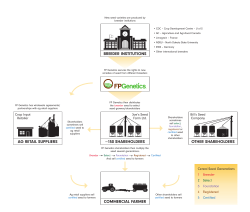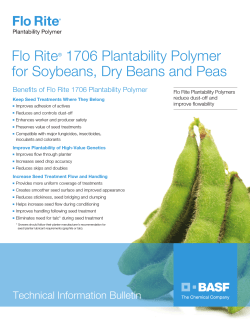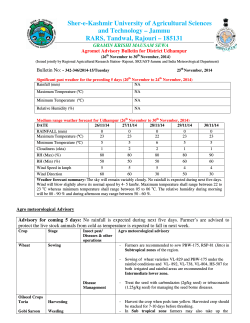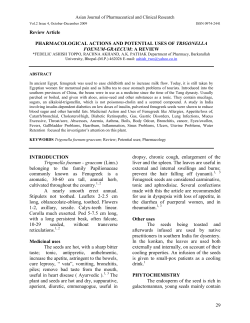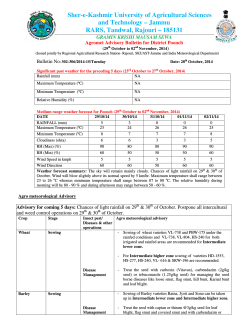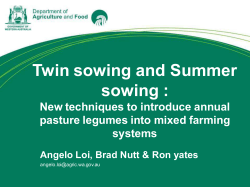
Document 122542
Growing Fenugreek (Trigonella foenum-graecum) Fenugreek (Trigonella foenum-graecum) is a member of the Fabaceae (previously and better known as legumes!). It has a multitude of uses including using the leaves fresh or dried, using the seeds whole or ground as a spice or the plant acts as an effective green manure to improve the soil Varieties Generally most seed catalogues do not give much choice or specify varieties of fenugreek. On allotments, it is commonly grown from the packets of seed spice available in Asian grocers (often called Methi or Mathi). There are two distinct forms. The more common large seeded variety has slightly larger leaves and white flowers. This variety can only be cut once so needs successional sowing. The smaller seeded variety has slightly smaller leaves, yellow flowers and will regrow after cutting. Cultivation Fenugreek does not like to be transplanted, so should be sown directly into a welldrained sunny spot. Sow 0.5 cm deep into drills 20 cm apart, aiming for a 5 cm spacing within row. It can be sown any time between April and August and will withstand some frost. Germination will normally take place within a week. The plant grows rapidly and is vigorous enough to compete against most weeds. The small leafed variety will continue to grow slowly throughout the winter whereas the larger one will generally die off. Although fenugreek is a legume, it doesn’t always fix nitrogen. For this to happen, the right bacteria (Rhizobium meliloti) need to be present in the soil. These are more likely to be present, if fenugreek has been grown on the site before. To see if the plants are fixing nitrogen, carefully dig (don’t pull!) up a plant and look for pink coloured nodules (2mm diameter) on the roots. Plants that are fixing nitrogen should be able to produce lush green growth on a low fertility soil with few problems, whereas those that can’t tend to develop pale coloured leaves and smaller plants. Poor soil nutrient status can affect the flavour of the crop. Harvesting If you are harvesting the plants for leaves, cut the stem a few cm above the base when the plants are up to 25 cm tall. The larger white flowered variety will not regrow after flowering so needs successional sowing whereas the yellow variety can be cut a number of times and should be cut regularly to prevent it seeding and keep it productive. They will generally be ready by 6 weeks after sowing depending on the weather. The quality of leaves will decline once flower buds start to appear so try and harvest before then. Growing for seed As fenugreek seed can be obtained so cheaply and easily, it is not so commonly grown for seed in the UK. Fenugreek will flower and produce thin seed pods. Allow the pods to ripen and turn yellow on the plant then harvest shortly before the seed pods pop open. Growing for sprouts Fenugreek can also be sprouted as a salad and has a distinctive spicy taste. Be sure to use seed for sprouting or culinary use, (packets of seed spice are fine) not a seed that may have been treated with fungicide. Soak the seed overnight, rinse well then leave in a slightly damp jar on its side, rinsing twice a day (or use a proper bean sprouter!). The sprouts will be ready after a few days, and should be eaten before the sprouts are 3 – 4 cm long, otherwise they start to turn bitter. Uses Fenugreek has many uses that are too numerous to list here. The fresh leaves can be cooked, steamed or in a curry with potatoes in a similar way to spinach. Their flavour is quite mild. Leaves can also be dried and these have a more pronounced bitter taste used to flavour dishes. The seeds have a pungent bitter taste and characteristic smell that is a key constituent of curry powder. The bitter taste can be mellowed by roasting. They can be used whole or ground to flavour curries or rice dishes. In Egypt, the seeds are sweetened and used as a tea and in many Middle Eastern cultures, they are used in cakes and confectionary. The seeds are also reputed to have many medicinal properties including relieving joint pain, lowering blood sugar level and even restoring hair growth! Anton Rosenfeld / Sally Cunningham 2010 This leaflet is produced as part of the Sowing New Seeds Project. This is a lottery funded initiative aiming to produce a resource of information on growing advice, experiences and seeds to promote growing of exotic produce in the UK For further information email sowingnewseeds@gardenorganic.org.uk or visit www.sowingnewseeds.org.uk The Brook Trust
© Copyright 2025



